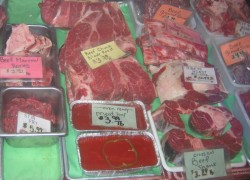Umami: The Meat of the Matter
When discussing umami, I have consistently described it as “savory,” “satisfying,” and “meaty.”
What is more “meaty,” than meat?
It is true that meat and poultry have a great deal of potential umami locked within them. Since umami is nothing but the flavor of amino acids, which are the building blocks of proteins and muscle tissue is made up of protein, then it stands to reason that meat is one of the greatest sources of natural umami one can use.
While there is umami in every kind of meat, there are some meats that are naturally endowed with more umami than others.
And that whole “darker fungi/wines/vinegars have more umami than lighter ones” rule of thumb doesn’t hold true with meat, strangely enough. According to the authors of The Fifth Taste: Cooking with Umami, poultry are richer sources of umami than beef. (Lamb has about as much umami as beef, veal and venison both are loaded with umami, and pork, unless it is a cured product has about as much potential umami as beef. However, cured pork products such as country ham, bacon or dry cured sausages are filled with umami, and greatly enhance any food with which they are cooked. Of course, just about anyone from the South could have told you that last part.)
However, the rule of thumb that involves age and umami does hold true when we are talking about most meats. In general, an older stewing hen will have more potential umami locked within her cellular structure than a young pullet, just as aged, complex red wines have more umami taste than a young, fruity red.
In addition, dry aged meats, such as beef and lamb, or pheasants and wild rabbits that are hung to age after slaughter, have more umami unlocked by the action of bacterial enzymes than meat that is cooked while still very fresh. (I am reminded in these two instances–the age of the animal before slaughter, and aging the meat after slaughter, of a saying my Gram always had. “Age before beauty,” she would say to me every time I held a door open for her. I don’t know if she would have frowned at my macabre application of her saying or bray with laughter.)
Another general rule when it comes to meat is that meat cooked on the bone or with the bones of the animal will have more flavor than boneless cuts of meat. That is because a great deal of umami is locked within the bone marrow, and in the connective tissues that hold muscle, fat and skin to the bone.
There are certain cooking methods that are best employed in order to unlock the amino acids that provide umami taste in meat. Marinating meats before cooking them in a liquid filled with umami ingredients such as red wine, vinegar, soy sauce, and perhaps the soaking liquid from dried mushrooms would go a long way toward creating an umami-rich dish. Searing meat in a hot pan before stewing, braising or turning it into soup not only browns the meat in a non-enzymatic, non-caramelizaton of simple sugars and amino acids known as the Maillard reaction, it also releases a plethora of amino acids from the meat to the surface of the meat. This changes the flavor and aroma of meat considerably. After searing, one can braise or stew the meat, a form of cooking which releases even more umami-bearing amino acids into the cooking liquid, which is usually consumed with the meat. (If the meat is cooked on the bone, then even more umami enters the cooking liquid via the bone marrow and connective tissues.)
That is why gravy is so darned good, somtimes even better than the meat it is meant to go with. It is good because it is jumping with amino acids, which are even easier for our body to break down and utilize than complete proteins that are in meat. That is also why stocks and broths all taste so wonderful as well–they are the simmered essence of amino acids.
Some people theorize that the fact that chicken broth and stock is filled with amino acids is part of why chicken soup is reputed to have such a restorative effect on sick people. It is a very nourishing liquid that not only tastes good, but is simple to digest.
How can a cook go wrong, really?
What have we learned in this installment?
1. Meat on the bone has more flavor than meat off the bone.
2. Don’t throw your bones away, save them in the freezer until you have a whole lot of them and then make stock, and save it, for it is liquid gold.
3. Age over beauty. Or, in other words, old stewing hens make better soups than pullets or fryers.
4. Dry aging, in whatever permutation that you use it, is good for most meats, particularly beef, venison and lamb.
5. Cured pork cures bland food. I am serious about that. A little bit of ham, jowl bacon, a smoked hock, or some bacon will bring flavor to anything you cook in it.
6. Brown your meat, whether you do so in the course of roasting or sauteeing or you do it before you braise or stew it. Pale meat is boring and bland. Don’t go there. And while you are at it, unless you like pale, rather tasteless stocks, roast your bones, and your vegetables in the oven before you chuck them in the stockpot with the wine and the water. Your stock will be the better for it. (And speaking of stock–here is another little saying for you. This one is from Chef Aukstolis, my instructor for “Stocks and Sauces.” “If your stock sucks, your sauce will suck.” So will your soup, stew or whatever else you make with it. So, to keep the stock from sucking, roast those bones.)
7. If you cook meat with other umami ingredients, you are only taking a good thing and making better. (Here is a third saying–“Too much is always better than not enough.” Points to anyone who knows where that obscure bit came from.)
So there are my thoughts on the umami of meat. Tomorrow look for an examination of umami in vegetables, and maybe even a book review.
2 Comments
RSS feed for comments on this post.
Sorry, the comment form is closed at this time.
Powered by WordPress. Graphics by Zak Kramer.
Design update by Daniel Trout.
Entries and comments feeds.




Barbara,
This is an excellent post!
First of all, if I didn’t know a single thing about you I would immediately guess that you were an instructor or teacher. You have a way of presenting information that is very enlightening.
Secondly, it’s funny because all those points you made (1 through 7) are all things that many of the older women in my family did on a regular basis! For example, my grandmother always saved bones and used them for broths.
And I know that in Italy, they always older fowl for soups.
And yet why is it that today, so many people disdain the idea of using these types of foods??? It’s beyond me!
Ok now that my rant is over … thanks again for your post!
Comment by Ivonne — January 9, 2006 #
Ivonne–you have found me out. I have been teaching culinary arts to hobbyists, young people and home cooks for years now. It is one of my chief joys in life to unlock the secrets of the kitchen for people.
As for the old ladies in your family–once again, I say, “Age before beauty.” Actually, if you ask me, age -is- beauty because there is nothing more beautiful than wisdom. And the ladies in your family sound like my grandmothers who taught all of these points well to me, even if they didn’t know what the word “umami” was.
They just knew how to make things taste good.
As for why people today don’t do these things? I don’t know–they don’t have time–that is a big one. Without someone staying home to cook all the time, and clean up and keep house, I guess no one has time to make stocks and such, except for crazy, driven people like myself who works from home, and so can run into the kitchen to check on the stockpot or the bones in the oven.
I think that there might be a bit of that, “Oooh, bones, yuck!” thing going on, too. I have very little patience for that, but I suppose you could figure that one out without me saying so.
I will stop ranting now, too!
Oh, and you are welcome for the post–and thank you for the rant! It was a good one.
Comment by Barbara — January 9, 2006 #